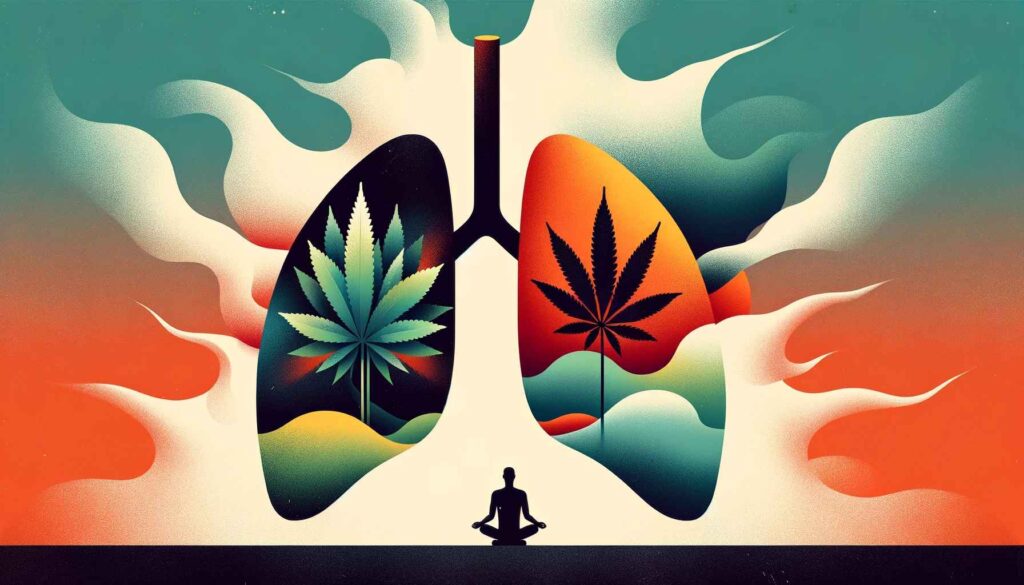The interest in studying the effects of marijuana on the lungs arises from the increasing global trend toward the legalization of cannabis for both medical and recreational use. This shift necessitates a deeper understanding of the potential health implications associated with marijuana consumption, particularly its impact on the respiratory system.
Cannabis Chemicals

Marijuana, derived from the Cannabis sativa or Cannabis indica plant, contains a complex array of chemical compounds that contribute to its psychoactive and therapeutic effects. The primary constituents of interest are cannabinoids, of which delta-9-tetrahydrocannabinol (THC) is the most well-known due to its potent psychoactive properties. Alongside THC, cannabidiol (CBD) is another significant cannabinoid, known for its non-psychoactive effects and potential therapeutic benefits, including anti-inflammatory and analgesic properties. In total, cannabis contains over 100 different cannabinoids, along with terpenes, flavonoids, and other compounds that contribute to its unique effects, aroma, and flavor profiles.
- Cannabinoids: The most notable chemicals in marijuana, responsible for its diverse effects. THC is the main psychoactive component, while CBD is known for its therapeutic effects without causing a high.
- Terpenes: These are aromatic compounds found in many plants, including cannabis, contributing to its smell and taste. Terpenes may also have health benefits and work synergistically with cannabinoids—a phenomenon known as the “entourage effect.”
- Flavonoids: Compounds that contribute to the pigmentation of the plant and have antioxidant properties.
- Other Harmful Substances: Similar to tobacco smoke, marijuana smoke contains a variety of harmful substances such as tar, ammonia, and carcinogens that can affect lung health.
Mechanisms of Influence on the Respiratory System

The act of smoking marijuana directly exposes the lungs to the smoke generated from burning cannabis. This smoke can irritate the respiratory system and lead to changes in lung function. Here are the primary mechanisms through which marijuana affects the respiratory system:
- Bronchial Irritation: Marijuana smoke can cause irritation of the bronchi and bronchioles, leading to inflammation, coughing, and increased mucus production.
- Altered Pulmonary Function: Regular smoking of marijuana has been associated with changes in lung function, including increases in airway resistance and lung hyperinflation.
- Impaired Mucociliary Clearance: Smoking marijuana can impair the function of cilia in the lungs, which are essential for clearing mucus and debris from the respiratory tract. This can increase the risk of respiratory infections.
- Potential for Chronic Bronchitis: Chronic marijuana smokers may experience symptoms of chronic bronchitis, such as chronic cough and sputum production.
- Increased Risk of Lung Infections: The immune-modulating effects of THC may increase susceptibility to lung infections, particularly in individuals with compromised immune systems.
Understanding the effects of marijuana on lung function is crucial for several reasons. Firstly, as the prevalence of marijuana use increases globally, so does the potential public health impact of its associated respiratory effects. Secondly, individuals with pre-existing respiratory conditions or compromised immune systems may be at increased risk of adverse effects from smoking marijuana. Thirdly, the therapeutic use of cannabinoids necessitates a balanced understanding of their benefits and potential harms, including those related to respiratory health.
Scientific Research and Statistics
Research into the effects of marijuana on the pulmonary system has yielded several important findings:
- Respiratory Symptoms: Studies have consistently shown that regular marijuana smokers report more symptoms of chronic bronchitis than non-smokers, including coughing on most days, phlegm production, wheezing, and shortness of breath.
- Lung Function: Evidence regarding marijuana’s impact on lung function over time is mixed. Some studies suggest that moderate use does not significantly affect lung function, while others indicate that heavy, long-term use can lead to decreased lung function.
- Pulmonary Infections and Lung Disease: The immunosuppressive effects of THC may increase susceptibility to pulmonary infections, such as pneumonia, in some users, especially those with pre-existing immune deficits. Moreover, there’s been concern about a potential association between chronic marijuana smoking and the development of lung cancer, although research has yet to conclusively prove this link.
- Acute Effects: Acute marijuana use increases heart rate and blood pressure, which can pose risks for individuals with cardiovascular disease—a factor to consider given the shared risk factors between heart and lung health.
Warnings Against Possible Negative Consequences
Given the available evidence, several warnings and considerations are warranted for individuals who use marijuana or are considering its use:
- Vulnerable Populations: Individuals with pre-existing respiratory conditions (such as asthma, chronic obstructive pulmonary disease, or cystic fibrosis) or a history of lung infections should be particularly cautious, as marijuana smoke can exacerbate these conditions.
- Heavy Use: The risks associated with marijuana use, particularly through smoking, appear to increase with the frequency and duration of use. Heavy users should be aware of the potential for diminished lung function and increased risk of respiratory symptoms.
- Alternative Methods of Consumption: To mitigate the risks to lung health, alternative methods of marijuana consumption, such as vaporization or edibles, may be considered. However, these methods also carry their own risks and uncertainties, and the long-term effects are not fully understood.
- Need for Further Research: There is a clear need for further longitudinal studies to fully understand the impact of marijuana use on lung health, especially given the increasing potency of marijuana products and changing patterns of use.
Cannabis smoke vs Tobacco smoke

While smoking marijuana and tobacco share several respiratory risks, there are significant differences. Additionally, the unique pharmacological properties of cannabinoids and the broader spectrum of consumption methods available for marijuana use offer both challenges and opportunities in understanding and mitigating its health impacts compared to traditional tobacco smoking.
Similarities in Respiratory Risks
- Inhalation of Combustion Products: Both marijuana and tobacco smoke contain a complex mixture of particulate matter and gases, including carcinogens and other toxic substances. The act of smoking either substance exposes the lungs to these harmful chemicals, which can cause lung irritation, inflammation, and an increased risk of respiratory infections and chronic bronchitis.
- Respiratory Symptoms: Chronic smokers of both substances may experience similar respiratory symptoms, such as coughing, wheezing, shortness of breath, and increased mucus production.
- Potential for Chronic Obstructive Pulmonary Disease (COPD): There is evidence to suggest that smoking marijuana may increase the risk of developing COPD, a risk well-established for tobacco smoking.
Differences in Respiratory Risks
- Carcinogenic Risk: Tobacco smoking is conclusively linked to lung cancer, among other cancers. The evidence linking marijuana smoking to lung cancer is less clear, with studies providing mixed results. This may be partially due to the differences in how frequently and how much of each substance people typically consume.
- Pulmonary Function: Tobacco smoking is associated with a decrease in lung function over time, contributing to the development of COPD. Some studies suggest that marijuana smoking may not have the same degree of impact on lung function, particularly in moderate users, although heavy use is associated with symptoms of bronchitis and other lung issues.
- Secondhand Smoke Exposure: Both marijuana and tobacco secondhand smoke contain harmful substances, but the research on the health effects of secondhand marijuana smoke is less extensive than that on tobacco smoke. Preliminary studies suggest secondhand marijuana smoke can impair blood vessel function; however, the long-term implications require further investigation.
Unique Aspects of Cannabinoids
- Immunomodulatory Effects: THC and other cannabinoids have immunomodulatory effects, which can influence the body’s ability to fight off infections. This aspect is particularly relevant for individuals with compromised immune systems and may not have a direct counterpart in tobacco use.
- Therapeutic Benefits: Unlike tobacco, cannabinoids in marijuana, such as THC and CBD, have recognized therapeutic benefits, including pain relief, reduction of nausea and vomiting, and appetite stimulation. These effects can be particularly beneficial for individuals undergoing chemotherapy or those with chronic pain and certain neurological disorders.
- Method of Consumption: Marijuana offers a variety of consumption methods beyond smoking, such as vaporizing, edibles, and oils, which may not carry the same respiratory risks as smoking. While these methods might mitigate some of the lung health concerns, they introduce other variables into the comparative analysis with tobacco.
Alternative Methods of Marijuana Use

- Vaporization: Vaporizers heat cannabis to a temperature that releases cannabinoids in a vapor, without burning the plant material. This method significantly reduces the exposure to harmful smoke toxins. Both flower and concentrate forms of cannabis can be vaporized. For all heavy smokers who are not considering reducing the frequency of smoking or switching to other forms of use, I almost always strongly recommend switching to vaporization.
- It is important to note that disposable vapes can be dangerous, it’s a cat in a poke. By vaporizers, I mean stationary or pocket tools in which the user places a product known in any form. This method will greatly help your lungs.
- Edibles: Cannabis-infused foods and drinks bypass the respiratory system entirely. The onset of effects is slower and can be more difficult to dose accurately, but this method eliminates the risks associated with inhalation.
- Tinctures: Cannabis tinctures are liquid extracts that can be taken sublingually (under the tongue) or added to food and drinks. They offer dose control and avoid inhalation risks.
- Topicals: Cannabis-infused creams, balms, and oils are applied directly to the skin for localized relief of pain or inflammation without psychoactive effects.
Hot to Minimize Pulmonary Impact

- Acute vs. Chronic Use: Acute (occasional) use of cannabis may have different health implications than chronic (regular) use. For instance, chronic use has been associated with tolerance to some effects of cannabinoids, potential impact on mental health, and respiratory issues (if smoked), whereas acute use may lead to temporary impairments in memory, coordination, and judgment.
- Therapeutic/Recreational vs. Toxic Effects: The dosage of cannabinoids is critical in determining their health effects. Low to moderate doses may provide therapeutic or recreational benefits, such as pain relief and anxiety reduction, good mood, while high doses can lead to adverse effects, including increased anxiety, paranoia, and psychosis-like reactions.
- Choose Non-Smoking Alternatives: Whenever possible, opt for methods of consumption that do not involve inhalation of smoke or vapor, such as edibles, tinctures, and topicals.
- Use Vaporizers with Caution: If inhalation is preferred, use vaporizers that heat cannabis at controlled temperatures to reduce the inhalation of combustion products. Ensure that the device is from a reputable manufacturer and avoid temperature settings that may degrade the product into harmful compounds.
- Maintain Clean Devices: Regularly clean your devices to prevent the buildup of harmful residues that could be inhaled.
- Stay Informed About Product Safety: Be aware of the source and quality of cannabis products. Opt for products tested for contaminants, such as pesticides, mold, and heavy metals, particularly when choosing concentrates for vaporization.
- Individual Variability: There is considerable variability in how individuals respond to cannabinoids, influenced by factors such as body weight, metabolism, and previous exposure to cannabis. This variability underscores the need for personalized dosing strategies.
New Technologies and Devices
The cannabis industry has seen significant innovation in developing devices and technologies aimed at safer consumption:
- Precision Vaporizers: Newer vaporizers offer precise temperature control, allowing users to avoid the harmful byproducts of combustion and customize their experience to optimize the release of desired cannabinoids.
- Water Filtration Devices: Water pipes and bubblers can cool and somewhat filter smoke, but they are less effective at reducing harmful substances compared to vaporization. Nonetheless, advancements in water filtration technology continue to improve their efficacy.
- Edible and Tincture Innovations: The market for edibles and tinctures has expanded rapidly, with products designed for rapid onset or sustained release, offering users more control over their experience.
- Dosage Control Tools: Devices and apps that help users measure and track their consumption can aid in achieving desired effects while minimizing risks.
Key Points on Marijuana and Lung Health

Respiratory Risks: Smoking marijuana is associated with increased respiratory symptoms such as coughing, phlegm production, and wheezing, as well as potential changes in lung function. However, the evidence linking marijuana smoke to chronic lung diseases and lung cancer is less definitive compared to tobacco smoke.
Frequency and Dosage Considerations: The frequency of use and dosage of marijuana significantly affect health outcomes. Chronic and heavy use poses greater risks, including potential for addiction and impaired lung function, whereas moderate use has been associated with fewer adverse effects.
Alternative Consumption Methods: Safer methods of marijuana consumption, such as vaporizing, edibles, tinctures, and topicals, offer alternatives to smoking by minimizing or eliminating exposure to harmful combustion products. These methods are preferred for reducing respiratory risks.
Individual Differences: Factors such as age, pre-existing health conditions, and genetic predispositions play crucial roles in determining an individual’s risk profile and response to marijuana. Younger individuals and those with pre-existing conditions may face higher risks.
Importance of Informed and Responsible Use
Informed Decision-Making: Access to accurate, science-based information is crucial for individuals to understand the potential risks and benefits associated with marijuana use. Knowledge empowers users to make informed decisions regarding consumption methods, dosages, and frequency.
Responsible Consumption Practices: Users are encouraged to adopt responsible consumption practices, such as opting for safer methods of use, moderating consumption, and being mindful of the legal and social implications of marijuana use.
Health Monitoring and Professional Guidance: Regular monitoring of respiratory and overall health, especially for chronic users, is important. Seeking professional medical advice can provide personalized insights and recommendations, ensuring that the use of marijuana does not adversely affect health.
Community and Dialogue: Engaging in open discussions about marijuana use, sharing experiences, and staying informed about new research can foster a community of responsible users. Dialogue helps dispel myths, reduce stigma, and promote a balanced understanding of cannabis.
In conclusion, the conversation around marijuana use, particularly its effects on lung health, emphasizes the need for a balanced and informed approach. Understanding the scientific evidence, acknowledging the potential risks, and considering individual health profiles are essential for responsible marijuana consumption. As society continues to evolve in its perception and legalization of cannabis, prioritizing informed decision-making and responsible use practices will be key to navigating the benefits and risks of marijuana.





Hi my loved one! I wish to say that this post is amazing, nice written and include approximately all vital infos. I’d like to peer more posts like this.